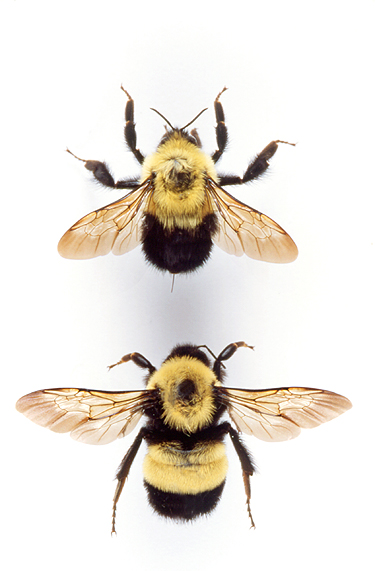Bumblebees (Bombus spp.)
Pricing: Dead (dried, spread): $50 & up for queens.
Geographic Range: Nearctic
View: Top View Sex: Female
Size: Wingspan: 2.5-3.5 cm (workers) / 4-4.5 cm (queens)
Availability Notes: Both queens and workers are available. Inquire about available species. Bombus bimaculatus shown above and Bombus vagans shown below.
In the temperate parts of North America, the emergence of queen bumblebees is a sure sign that spring is in full swing. Bumblebees are large, social bees that produce annual colonies. They are not aggressive and will generally mind their own business, unless molested. Mated queens over-winter in the soil and emerge from hibernation in early spring. Active from April through May, they feed on the nectar of various flowers as they search for a suitable location to build an underground colony (such as an abandoned rodent burrow). Once a nest site is found, the queen collects pollen and lays her first brood of worker eggs. Workers emerge about 21 days after the eggs are laid and soon take over the duties of pollen and nectar collection, as well as colony defense. This first batch consists of very small workers but the size of the worker bees increases with each new brood. The third caste of bumblebees, the males, is usually produced in midsummer. A brood of new queens will then be bred to mate with these males. Males only live long enough to provide the new queens with sperm for the foundation of new colonies. In fall, these new queens will fly off (with sperm stored inside them) and find a suitable place to hibernate for the winter. As the days grow shorter and colder, the old queen will die along with the rest of her faithful colony. Bumblebees are beneficial insects that pollinate many kinds of flowering plants. In fact, many rare, native plants are pollinated solely by bumblebees. Bombus vagans alone is responsible for the continued existence of several species of rare, sometimes endangered, U.S. flowers. Bumblebees are especially important as pollinators in the north, where they fly in cooler and damper conditions more often than other bees. Bumblebees are easily recognized by their dense coats of hair and the corbicula, or pollen baskets, on the hind tibiae of the females. There are about 50 species and subspecies of Bombus found in North America. Bumblebees thrive in the more temperate climes and become rarer in the south, especially southern Florida. None are known from the Keys.
